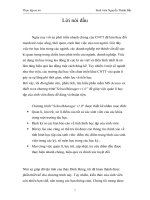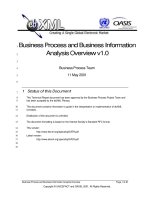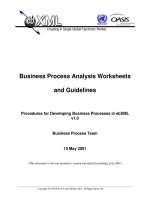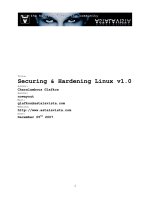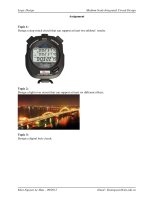Official minutes napsac 26 nov 2020 v1 0 docx
Bạn đang xem bản rút gọn của tài liệu. Xem và tải ngay bản đầy đủ của tài liệu tại đây (233.43 KB, 5 trang )
National Patient Safety Alerting Committee
Thursday 26th November 2020, 15:30 to 17:00
Attending
On behalf of (name)
On behalf of (organisation or alert-issuing body/team)
Aidan Fowler
-
Chair/NHS National Director of Patient Safety
Ted Baker
-
Deputy Chair/CQC
Jono Broad
-
PPV
Neill Vinter
-
PPV
Ethel Oldfield
-
Head of Patient Safety Oversight and Alerts/logistical
support to Committee
Cindy Taplin
-
Credentialing Manager/logistical support to Committee
Rebecca Chaloner
Sumaia Mashal
Department of Health and Social Care (PS portfolio)
-
DHSC – Medicine Supply Disruption*
David Wathey
DHSC – Medical Device Supply Disruption*
Bruce Warner
-
NHSE/I clinical advice for Supply Disruption
Michael Bellas
Simon Corban
NHS England & Improvement (Estates and Facilities) *
Frances Healey
-
NHS England & Improvement Patient Safety Alerts*
/leading team providing logistical support to Committee
Graeme Tunbridge
June Raine
MHRA (Medical Devices) *
Sarah Branch
June Raine
MHRA (Medication) *
Manpreet Pujara
Martin Severs
NHS Digital*
Jackie Lamberty
Amal Rushdy/Paul Cosford
Public Health England*
Kevin Harris
-
NICE
Alastair Henderson
-
Academy of Medical Royal Colleges
Keith Conradi
-
HSIB
Natasha Phillips
-
NHSX
Sue Tranka
NHS England & Improvement (CNO & HCAI)
* Indicates bodies/teams issuing their own alerts directly via current CAS process (or set up to do so)
Observers
Meera Sookee (for link to the National Quality Board)
Naomi Gregg (Scotland)
Sara Davies (Scotland)
Apologies
Amal Rushdy – Public Health England
Cathy Harrison (Northern Ireland)
Andrew Evans (for Wales)
Helen Causley – DHSC (may join for HSIB section)
Stephen Groves – EPRR
Jenny Harries - CMO
NHS England & Improvement on behalf of NaPSAC/National PS Committee
15:30
1. Welcome and introductions
AF – Welcomed all parties to the MS teams meeting and extended a welcomed to Ethel Oldfield who is the new
Head of Patient Safety Oversight & Alerts.
AF - Gave a brief overview on how the meeting would progress with the use of PowerPoint slides but asked
attendees to introduce themselves when speaking.
Importantly, it was noted that for this group to be as practical and functional as possible, that the membership
would be restricted to decision makers. The intention is that decision makers from organisations will attend,
robust discussions will be had around issues where we have shared responsibility, and people will agree to their
part. If you are unable to attend, you must send a deputy who has delegated authority.
The committee accepted that the notes and action logs from 20th January 2020, 9th July 2020, and 1st
September 2020 were accurate.
2. NATIONAL PATIENT SAFETY ALERTS (NaPSAC) section of meeting
15:35 –
15:45
2a. Accreditation process to date
CT – Gave an overview of the accreditation process to date. The patient safety team within NHSE/I have to date
issued 9 National Patient Safety Alerts and AF congratulated the MHRA, who have now published their first
National Patient Safety Alerts. It was also noted that other alert issuing bodies were all working towards their
goal of accreditation in 2021. It was noted that we still need to confirm leads for EPRR and the CMO’s office.
CT – Shared a quick overview of the number of alerts which have been issued from April to September 2018
compared to the same period for 2020, and noted that there had been a dramatic drop in non-critical alerts
being issued, and that showed that the credentialling process was having a positive impact even in
teams/bodies still working towards formal accreditation.
2a Accreditation
Process to date.pdf
AF – Emphasized the importance of alerts; noting that we have never seen alerts as being more important than
during the pandemic where it was essential to disseminate requirements for action at speed, noting that the
new National Patient Safety Alerts format have much clearer actions. We have also been reminded how some
historical alerts were confusing and could potentially lead to ongoing issues.
15:45 –
16:00
2b. Central Alerting System replacement and cross-ALB Safety Messaging/Safety Bulletins
Update on the Central Alerting System replacement
GT –Shared that the MHRA’s bid to the Treasury Departments Spending Review (SR) included a specific bid for
funding to replace CAS, roughly £4,5 million to cover the IT development and staffing costs involved, forecast
into 2021 to 2022. Noting that the MHRA is yet to discover how the settlement the Department of Health
receives will flow through the department and onto the ALB’s, and if the department would look favourably
upon this aspect of the bid or not. The MHRA expect to hear the outcome in early 2021. If the bid is successful
then it would take some time to do the work required, so noted that we would still be working with CAS as is,
for the foreseeable future, or at least the next year or so. It could go beyond that if the department did not
fund the redevelopment. Without funding from the SR, it is unlikely that the MHRA will be able to fund it by
themselves.
AF – asked Rebecca Chaloner (from DHSC) if we had an idea if this bid would be supported? RC noted that it
would be too early to say, the SR bid only landed on 25th November 2020, but shared that there are processes
within DHSC to look at where funding will be spent. Aidan requested that this issue be brought back to the
NHS England & Improvement on behalf of NaPSAC/National PS Committee
next meeting noting that it was critical, and that current circumstances had highlighted our concerns regarding
the current CAS system.
Action: GT to provide an update following the SR and CAS redevelopment as an agenda item for the next
meeting.
Proposed terminology changes to declaration of compliance on CAS
GT – Spoke to the slides (please see slides for in-depth detail).
2b Focusing CAS on
safety-crital communication.pdf
Group discussion
There was discussion that consideration should be given to rephrasing option 3, to be clear that an alert is
relevant for the organisation that one or more actions apply, and similarly to option 4 that none of the actions
are relevant, to make it abundantly clear, but there were also views that the alert topic rather than individual
actions were the right focus for ‘relevance’ and the National Patient Safety Alerts routinely specified the types
of provider each alert was relevant to. A concern was raised by BW regarding the amount of time an
organisation could spend without progress in the period after acknowledgement and thought that interim
stages could be considered in the redevelopment of CAS.
After the group discussion it was agreed that the committee was happy with the proposed changes to the alert
responses laid out in the slides. It was requested that the CAS team consider publishing the declared
compliance data in red/amber/green status report, using colour as an indicator of how long past deadline a
National Patient Safety Alerts remained incomplete rather than how many National Patient Safety Alerts per
organisation remained incomplete, as any one was a concern.
Update on cross-ALB Safety Messaging/cross ALB Safety Bulletins
GT – Reminded the committee that this was in relation to the action that the MHRA took away previously,
around coordinating cross ALB safety messaging outside of National Patient Safety Alerts. Due to the pandemic
and Brexit we have not been able to make this a priority. However, it is still an action we are carrying forward.
GT – Shared how the pilot medical devices bulletin is being developed within MHRA and wanted to discuss how
this could be broaden out to include other ALBs. Explained that the Devices team decided to introduce a
fortnight medical devices safety bulletin, a crisp 2 pager, a roundup of key issues and occasional spotlight on
issues, this has replaced some of the other communications we had. This is currently distributed through CAS,
as we have no other means available at this stage. But shared that there are plans to redevelop our gov.uk
webpages and develop some safety landing pages to enable us to stop pushing the information through CAS.
Initially that page will be focused on medical devices and then we will incorporate other safety messaging work
within the agency so we can produce a one stop shop and move progressively away from CAS once we are
confident that we have an alternate route and that we understand the impact of doing that. Once the MHRA
have their own house in order over the next few months then they will be able to pick up the action of starting
conversations across ALBs.
Group discussion followed and summarised by AF - we must seek to reserve CAS for the active push out of
requirements to take action on safety critical issues, and to resist the temptation to cascade information on
problems which have no clear solution or are not safety critical; this may makes us feel better but is shifting the
problem rather than helping the service to improve. We should be saying how can the MHRA safety
information on medical devices be a resource that people find useful, timely, relevant and easy to digest, where
people see it as an authoritative place to go for information, rather than the notion of a safety blanket where
we push out all safety messages and then step back and say disaster averted. Where moving from a push
system to a pull system we would need to be assured that the people were looking at the information e.g. via
log in to gain access so meta data is available as monitoring tool.
NHS England & Improvement on behalf of NaPSAC/National PS Committee
16:00 –
16:05
2c. CQC’s role in relation to National Patient Safety Alerts
TB – Provided a brief update and highlighted the following:
• CQC have issued new guidance to staff, so they are aware of the new published alerts, closing dates and
guidance on how the implementation of alerts should be assessed throughout the regulatory process.
• CQC’s insight product assesses and identifies risks using metrics. These metrics have been developed
jointly with NHSE&I to ensure that the metrics identify risks in a system when alerts have not been
implemented or where there are other risk factors. This has already identified some trusts which have a
significant backlog of incomplete alerts.
• CQC are developing a monitoring system to try and reduce the need for onsite inspections, this is a
transitional approach and is still developing. Built into that, we have questions where we are asking trusts
about their implementation of National Patient Safety Alerts. These questions are designed to identify what
assurances trusts have around the implementation of National Patient Safety Alerts. This will be central
going forward. If we do undertake risk-based inspections these will be driven by something we have
identified from our risk assessment or from other information we receive from other bodies about risks
within systems.
• A risk-based inspection is focused on safety as a central theme under the current circumstances. There is
some work going on in our mental health inspections teams around issues with anti-ligature guidance
which we are working in partnership with the patient safety team to make sure we are implementing that
in a consistent way.
• CQC’s strategy for the next 5 years will be going out for consultation in the new year, a central theme is
around safety. We are looking at culture and safety expertise and the approach that organisations must
implement National Patient Safety Alerts consistently. We will be assertively looking at National Patient
Safety Alerts to move from a culture where people feel that alerts are one more thing to do, to one where
they are central to driving safety forward.
16:0516:10
2d. Process between re-accreditations
Self-assessment between formal re-accreditation cycles
FH – Spoke to the slides (please see slides for in-depth detail)
2d NaPSAC Process
between re-accreditations.pdf
Group Discussion
A request was made by JB to amend to point 3, suggesting that it should read, ‘that we suggest that it have
fresh eyes by involving a patient & public voice AND a senior colleague’ rather than ‘OR’. All agreed to the
amendment. BW also asked if there would be guidance and common audit standards to do their audit against,
to ensure consistency in the self-audit process. FH noted that it is a reassessment against the standards you
are accredited on, so effectively they are already laid out and agreed by the committee.
FH – Noted if the committee was broadly in agreement with the suggestions then a more detailed protocol
would be written up and shared with the committee via email for agreement.
The committee confirmed it agreed with the proposed process.
Concerns raised between re-accreditation
FH spoke to the slides (please see slide pack)
2d NaPSAC Process
between re-accreditations.pdf
NHS England & Improvement on behalf of NaPSAC/National PS Committee
Group Discussion
It was agreed that CQC should be informed of any substantiated concerns raised, because they may not want to
pursue enforcement on National Patient Safety Alerts where the content was not in line with agreed criteria. All
agreed this should be included into the stages.
JB asked whether the committee should suspend the accreditation of an alert issuer who had committed a
third offense until evidence had been submitted to the committee that the issuer had taken all corrective
action needed to conform to the standards. In discussion it was felt that the committee should adopt a
principle of keeping an organisation functioning until we had the appropriate evidence. But that should
National Patient Safety Alert issuer reach stage 3, instead of waiting for the next scheduled committee meeting,
that a special short meeting would be called.
Action: EO to revise stages to reflect comments
17:00
Close & thanks
AF –Asked the committee to give some thought to the TOR and to consider the membership for the National
Patient Safety Committee, reiterating that the committee needs to be tight, not to be exclusive but it is
important to have decision making people, this committee needs to be decisive.
Chair: Thanked all members for attending the meeting and wished all a good Christmas.
NHS England & Improvement on behalf of NaPSAC/National PS Committee

